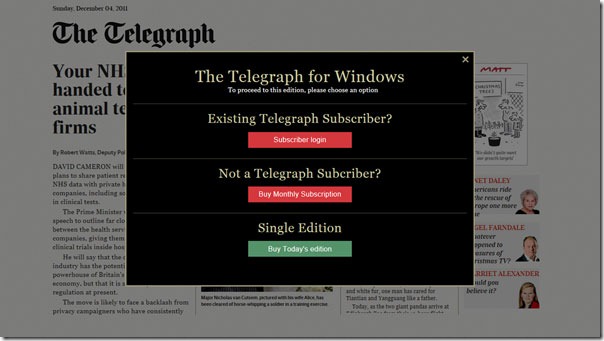In this edition of The Midweek Download, we’ve got stories for developers on the new Windows Store, Windows 8, Internet Explorer 10 and Silverlight.
Previewing the Windows Store. On Tuesday, Microsoft gave developers their first glimpses of the Windows Store, which will make it easy for Windows customers to find, try and buy useful, high-quality apps from practically anywhere in the world once the next version of Windows – codenamed “Windows 8” – becomes available to the general public. With Windows 8 and the Windows Store, developers can enjoy a built-in distribution and update mechanism for their apps. Built using HTML5 and JavaScript, the Windows Store is a fast, fluid, full-screen Metro-style app taking advantage of the Metro-style design principles inspired in Windows 8. We also unveiled a new Windows Store Blog, which will help start a dialogue between Microsoft and developers. Below is a screen shot of a third-party transaction platform from the United Kingdom’s Daily Telegraph newspaper:
Enabling large disks and large sectors in Windows 8. “One of the most basic services provided by an OS is the file system, and Windows has one of the most advanced file systems of any operating system used broadly. In Windows 7 we improved things substantially in terms of reliability, management, and robustness (for example, automating completely the antiquated notion of “defrag”). In Windows 8 we build on this work by focusing on scale and capacity,” writes Steven Sinofsky, president of the Windows and Windows Live Division, in this Nov. 29th post on Building Windows 8. Check it out.
From the IEBlog: Working with binary data using typed arrays. With HTML5 comes many APIs that push the envelope on user experiences involving media and real-time communications. These features often rely on binary file formats, like MP3 audio, PNG images, or MP4 video. The use of binary file formats is important to these features to reduce bandwidth requirements, deliver expected performance, and interoperate with existing file formats. But until recently, Web developers haven’t had direct access to the contents of these binary files or any other custom binary files. This Dec. 1st post on the IEBlog explores how Web developers can break through the binary barrier using the JavaScript Typed Arrays API, and explore its use in the Binary File Inspector Test Drive demo.
Big data and Microsoft’s codename Data Explorer. As more and more devices get connected to the world, the amount of data is going to explode but amassing data has never really been a problem. Making sense of that data has which is why Next at Microsoft Blog Editor Steve Clayton was keen to hear more about a project from our SQL Azure Labs known as “Data Explorer”. Read more about this story in this Tuesday blog post.
Ten laps around Silverlight 5. The Silverlight team is getting close to wrapping up its 10-part series on Silverlight 5. Developers can find part eight of the series on the Silverlight Blog. Don’t miss it.
That’s it for this edition of The Midweek Download. Thanks for reading!
Posted by Jeff Meisner
Editor, The Official Microsoft Blog


